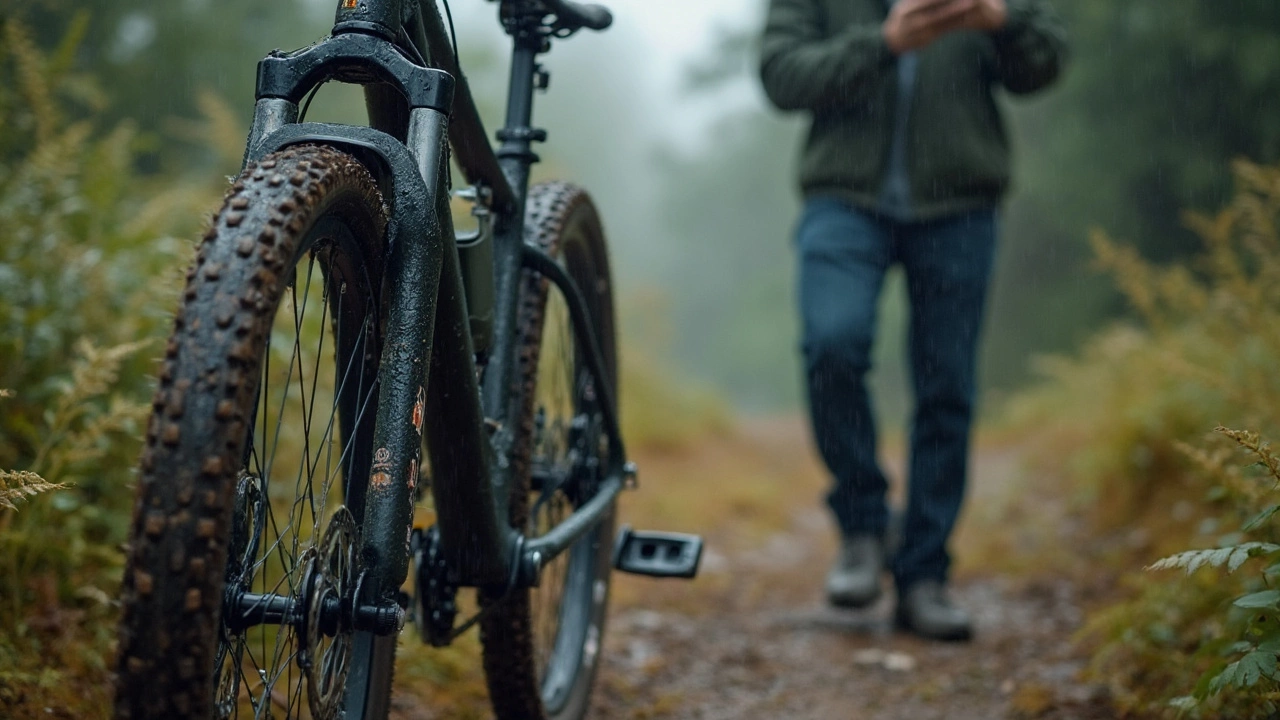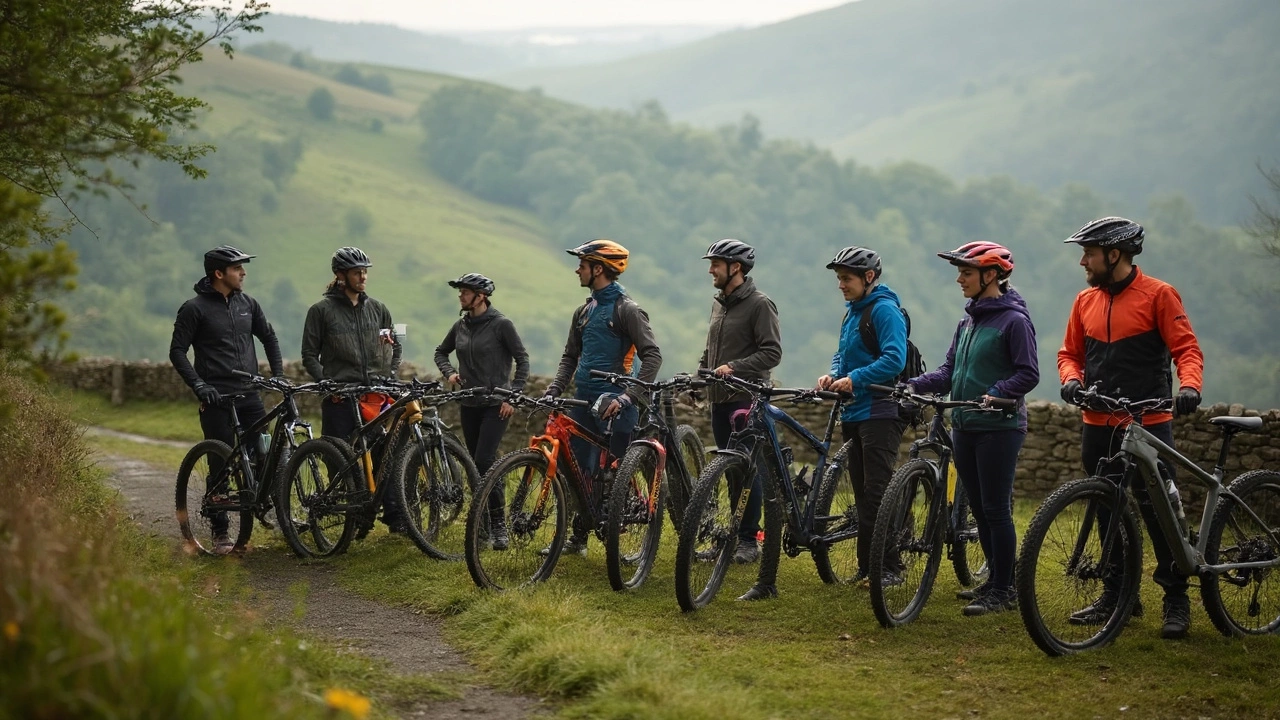If you think dropping less than $500 on the best mountain bike under 500 means you’re stuck with clunky junk—think again. These days, $500 can actually get you a reliable ride that’ll handle real trails, not just bike paths or groceries. But you need to know where to look, what to expect, and how to avoid the duds.
There’s a catch, of course. At this price, you’re not getting the latest carbon frames or high-end suspension. But if you’re smart about the basics—frame material, gears, brakes, and wheel size—you can get a bike that’s way more fun than you’d expect. Most good options use aluminum frames, enough gears to get up steep hills, and disc brakes for real stopping power. And with big names like Schwinn, Giant, and Trek offering decent entry-level models, you don’t even have to gamble on no-name brands.
Don’t ignore used bikes though. For $500, a well-cared-for used bike can outshine any new one. Just watch for worn parts—check the chain, brakes, and tires. And make sure the frame isn’t cracked or bent. If you’re new to this, bring a buddy who knows bikes, or snap some pics and post in a bike Facebook group to get feedback on your find.
- What Does $500 Get You in a Mountain Bike?
- Top Picks: Best Mountain Bikes Under 500 Right Now
- Must-Have Features and What to Skip
- Tips for Getting the Most Out of Your Budget Bike
What Does $500 Get You in a Mountain Bike?
Let’s talk straight: $500 won’t get you a pro race bike, but it absolutely gets the average rider a solid, capable machine for actual trails. This price range is perfect for beginners or anyone who wants a good backup bike without overspending. So, what can you expect?
- Frame Material: Most bikes under $500 use aluminum frames, which are light, strong, and don’t rust easily. Steel frames sometimes pop up, and while they’re heavier, they can take a beating.
- Drivetrain: Expect 7 to 9 gears in the back and one or two upfront. Not as flashy as pricier bikes, but you’ll have enough gears for steep climbs and chill rides.
- Brakes: Mechanical disc brakes are now common, giving you way better stopping power than old-school rim brakes. Don’t expect hydraulic discs here; those only show up on bikes over $600.
- Wheel Size: Most bikes use either 27.5-inch or 29-inch wheels. 27.5 is great for quick turns, 29 rolls smoother over rocks and roots. Both get the job done.
- Suspension: You’ll see front suspension (called a hardtail). Most forks have about 80-100mm of travel, which is enough to take the sting out of bumps. Rear suspension is really rare at this price and usually means big weight and low quality.
To make this clear, check out how bikes under $500 stack up in the basics:
| Feature | What To Expect |
|---|---|
| Frame | Aluminum or steel, sizes vary |
| Gears | 14–21 speeds, entry-level stuff |
| Brakes | Mechanical disc (some rim brakes) |
| Suspension | Front only, up to 100mm travel |
| Wheel Size | 27.5" or 29" |
You won’t get top-tier brands like Shimano Deore or SRAM SX in the drivetrain, but basic Shimano or SRAM setups run just fine if you keep them clean and adjusted. Most models also come with basic pedals and a saddle, but you might want to upgrade those for comfort down the road.
One thing to keep in mind: the best mountain bike under 500 isn’t just about the spec sheet. It’s about finding a bike that fits your body and your local trails. Focus on the basics, ignore the marketing, and you’ll avoid most headaches.
Top Picks: Best Mountain Bikes Under 500 Right Now
The search for the best mountain bike under 500 isn’t just about grabbing the one with the flashiest paint job. You want gear that’s tough, smooth to ride, and built with real parts that last. Here’s a rundown of some crowd favorites in this price range, picked for reliability, performance, and real-world street cred.
- Schwinn High Timber: People love this one because it’s surprisingly decent for the price. Aluminum frame means lighter weight, and both 24" and 29" wheel options let you pick what fits best. It’s got 21 speeds to hammer up hills and disc brakes for stopping confidence.
- Co-op Cycles DRT 1.1: This REI-exclusive bike is a hit among beginners. The steel frame takes a beating, the 21-speed Shimano drivetrain shifts clean, and wide, grippy tires give solid trail control. The catch? Sometimes you’ll find it just over $500, but if you catch a sale or look used, it sneaks under the line.
- Huffy Stone Mountain: If your budget is super tight, this one fits the bill. It’s everywhere at big box stores. Okay for mellow trails and commuting, but don’t expect it to crush black-diamond runs at your local bike park.
- Trek Marlin 4 Gen 2: Trek’s entry-level mountain bike pushes close to the $500 limit, but it does everything you need—aluminum frame, Shimano gears, rack mounts, and it’s backed by a big brand warranty.
Here’s a quick comparison to help you eyeball the specs:
| Model | Frame Material | Gears | Brakes | MSRP (May 2025) |
|---|---|---|---|---|
| Schwinn High Timber | Aluminum | 21 | Mechanical Disc | $449 |
| Co-op Cycles DRT 1.1 | Steel | 21 | Mechanical Disc | $499 (sale) |
| Huffy Stone Mountain | Steel | 18 | V-brake | $329 |
| Trek Marlin 4 Gen 2 | Aluminum | 14 | Mechanical Disc | $529 (look for deals) |
Buying tip: If you land a model with disc brakes and at least 14 speeds, you’re set for most trails. And don’t sweat over the brand—what matters is fit, comfort, and if you can get replacement parts easily. Stick to the major retail and bike shop brands if you want hassle-free service down the road.

Must-Have Features and What to Skip
Shopping for the best mountain bike under 500 means staying sharp on which features are real upgrades and which are just marketing noise. Here’s what you should look for if you want your ride to last more than a summer.
- Aluminum Frame: Steel is solid but a pain to haul uphill. Aluminum is light and strong. Most brands use it now for good reason—it’ll save you fatique on long rides.
- Front Suspension Fork (Hardtail): Don’t expect full suspension without cutting corners elsewhere. A basic front shock soaks up rough stuff and climbs way better.
- Disc Brakes: Mechanical disc brakes are a serious step up from cheap rim brakes. They work better in mud or rain. Skip hydraulic discs unless you score a crazy deal—they’re rare at this price anyway.
- Decent Drivetrain: Look for at least 7 to 8 gears in the back. Shimano Tourney, Altus, and MicroSHIFT are common and solid. Fewer than 21 total speeds? You’ll wish you had more on the hills.
- Proper Tire Clearance: You want at least 2.1” wide tires for real trail grip. Any skinnier and you’re likely slipping around.
- Threadless Headset: Older, threaded headsets are more work to keep tight. Threadless is the modern standard—even at this price.
And what’s okay to skip? Let’s keep it real:
- Rear Suspension: Entry-level dual-suspension bikes are heavy and sloppy. Hardtails are lighter, simpler, and tougher for real riding.
- Internal Cable Routing: Looks sweet but makes repairs a pain. Not worth the hassle for most beginners.
- Quick-Release or Thru-Axle: Standard quick-release wheels are fine. Thru-axles look pro but almost never show up under $500.
- Fancy Paint Jobs: Killer color won’t save you from cheap components. Go for function first.
Still not sure what’s best? Check out this breakdown of the must-have basics compared to "nice-to-have" features at this price range:
| Feature | Must-Have | Skip |
|---|---|---|
| Frame | Aluminum | Steel (unless you like a heavy ride) |
| Brakes | Mechanical Disc | Hydraulic Disc (rare or unreliable<) |
| Suspension | Front Suspension (Hardtail) | Full Suspension |
| Gearing | 7-8 Speed Rear, Shimano/MicroSHIFT | Less than 21 total speeds |
| Tires | 2.1" or wider | Skinny hybrid tires |
Stick to these basics, and your budget will go where it actually matters: a bike that really rides, not just looks good in photos.
Tips for Getting the Most Out of Your Budget Bike
Want to make your ride smoother and keep your best mountain bike under 500 running strong? It all starts with a little know-how and some basic TLC. Even a $400 or $500 bike can take on local trails if you keep these tips in mind.
- Keep It Clean: After muddy rides or rainy days, hose off the frame and gears, but skip the high-pressure blast—too much force can mess with bearings. A quick wipe-down keeps mud from eating away at your moving parts.
- Lube the Chain: A dry chain ruins your ride fast. Use bike chain lube (not WD-40) after every couple of rides. Wipe off the extra so it doesn’t pick up dirt.
- Tire Pressure Matters: Under-inflated tires slow you down and make flats more likely. Most mountain bike tires work well at 30–40 psi for trails. Check the sidewall for your tire’s sweet spot.
- Check Your Bolts: Vibrations shake stuff loose. Every few weeks, give your stem, handlebars, seat post, and wheels a once-over with a multi-tool.
- Swap Cheap Parts First: A comfy saddle or decent grips make way more difference than you’d think. If you have a bit of extra cash, put it on tires—grippy rubber makes even entry-level bikes feel better on dirt.
- Upgrade When You Outgrow It: If you ride more and hit tougher trails, it might be time for a better fork or brakes. On the best starter bikes, small upgrades (like metal pedals or better brake pads) are cheap and noticeable.
Want to know how much basic upgrades and maintenance cost? This simple breakdown should help:
| Upgrade/Maintenance | Estimated Cost (USD) |
|---|---|
| Chain Lube (per bottle) | 8–15 |
| Multi-tool | 10–25 |
| Decent Saddle | 25–50 |
| High-quality Grips | 12–30 |
| Upgraded Tires (pair) | 40–80 |
| Entry-level Metal Pedals | 20–40 |
Don’t forget local bike shops. They’ll help with tune-ups, offer upgrade ideas, and show you install tricks if you’re stuck. Most importantly, ride often and have fun. The more you ride, the more you’ll notice what really needs tweaking and what can wait. That’s how you squeeze real value out of a budget mountain bike.
